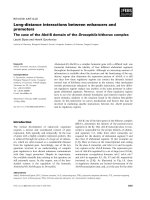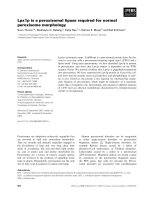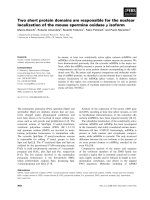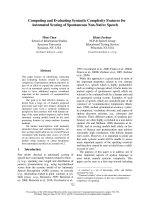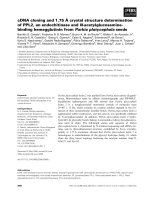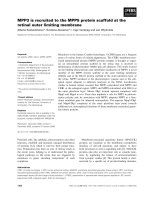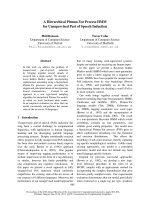Báo cáo khoa học: "SOFA is superior to MOD score for the determination of non-neurologic organ dysfunction in patients with severe traumatic brain injury: a cohort study" doc
Bạn đang xem bản rút gọn của tài liệu. Xem và tải ngay bản đầy đủ của tài liệu tại đây (203.13 KB, 10 trang )
Open Access
Available online />Page 1 of 10
(page number not for citation purposes)
Vol 10 No 4
Research
SOFA is superior to MOD score for the determination of
non-neurologic organ dysfunction in patients with severe
traumatic brain injury: a cohort study
David Zygun
1,2,3
, Luc Berthiaume
1,4
, Kevin Laupland
1,3,4
, John Kortbeek
1,5
and
Christopher Doig
1,3,4
1
Department of Critical Care Medicine, University of Calgary, Calgary, Alberta, Canada
2
Department of Clinical Neuroscience, University of Calgary, Calgary, Alberta, Canada
3
Department of Medicine, University of Calgary, Calgary, Alberta, Canada
4
Department of Community Health Sciences, University of Calgary, Calgary, Alberta, Canada
5
Department of Surgery, University of Calgary, Calgary, Alberta, Canada
Corresponding author: David Zygun,
Received: 29 May 2006 Revisions requested: 29 Jun 2006 Revisions received: 19 Jul 2006 Accepted: 1 Aug 2006 Published: 1 Aug 2006
Critical Care 2006, 10:R115 (doi:10.1186/cc5007)
This article is online at: />© 2006 Zygun et al.; licensee BioMed Central Ltd.
This is an open access article distributed under the terms of the Creative Commons Attribution License ( />),
which permits unrestricted use, distribution, and reproduction in any medium, provided the original work is properly cited.
Abstract
Introduction The objective of the present study was to compare
the discriminative ability of the Sequential Organ Failure
Assessment (SOFA) and Multiple Organ Dysfunction (MOD)
scoring systems with respect to hospital mortality and
unfavorable neurologic outcome in patients with severe
traumatic brain injury admitted to the intensive care unit.
Method We performed a prospective cohort study at Foothills
Medical Centre, the sole adult tertiary care trauma center
servicing southern Alberta (population about 1.3 million). All
patients aged 16 years or older with severe traumatic brain injury
and intensive care unit length of stay greater than 48 hours
between 1 May 2000 and 31 April 2003 were included. Non-
neurologic organ dysfunction was measured using the SOFA
and MODS scoring systems. Determination of organ
dysfunction for each non-neurologic organ system was
compared between the two systems by calculating the
proportion of patients with SOFA and MOD component score
defined organ failure. Consistent with previous literature, organ
system failure was defined as a component score of three or
greater.
Results The odds of death and unfavorable neurologic outcome
in patients with SOFA defined cardiovascular failure were 14.7
times (95% confidence interval [CI] 5.9–36.3) and 7.6 times
(95% CI 3.5–16.3) that of those without cardiovascular failure,
respectively. The development of SOFA-defined cardiovascular
failure was a reasonable discriminator of hospital mortality and
unfavorable neurologic outcome (area under the receiver
operating characteristic [ROC] curve 0.75 and 0.73,
respectively). The odds of death and unfavorable neurologic
outcome in patients with MOD-defined cardiovascular failure
were 2.6 times (95% CI 1.24–5.26) and 4.1 times (95% CI
1.3–12.4) that of those without cardiovascular failure,
respectively. The development of MOD-defined cardiovascular
failure was a poor discriminator of hospital mortality and
unfavorable neurologic outcome (area under the ROC curve
0.57 and 0.59, respectively). Neither SOFA-defined nor MOD-
defined respiratory failure was significantly associated with
hospital mortality.
Conclusion In patients with brain injury, the SOFA scoring
system has superior discriminative ability and stronger
association with outcome compared with the MOD scoring
system with respect to hospital mortality and unfavorable
neurologic outcome.
Introduction
Multiple organ dysfunction syndrome is a major cause of death
in multisystem intensive care unit (ICU) patients. Similar to all
critically ill ICU patients, patients with life-threatening neuro-
CI = confidence interval; FMC = Foothills Medical Centre; GCS = Glasgow Coma Scale; GOS = Glasgow Outcome Score; ICU = intensive care
unit; MOD = Multiple Organ Dysfunction; OR = odds ratio; PAR = pressure-adjusted heart rate; ROC = receiver operating characteristic; SOFA =
Sequential Organ Failure Assessment; TBI = traumatic brain injury.
Critical Care Vol 10 No 4 Zygun et al.
Page 2 of 10
(page number not for citation purposes)
logic injury are at risk for development of multiple organ dys-
function syndrome. However, non-neurologic organ
dysfunction has been described in patients with neurologic
injury in the absence of the usual etiologic associations,
namely infection or systemic traumatic injury. Therefore, severe
neurologic injury represents an additional risk factor for the
development of the multiple organ dysfunction syndrome.
Importantly, the development of non-neurologic organ dys-
function, independent of the severity of neurologic injury, was
recently associated with unfavorable outcome in patients with
subarachnoid hemorrhage [1] and severe traumatic brain
injury (TBI) [2].
Although several multiple organ dysfunction scoring systems
[3] have been described, the Sequential Organ Failure
Assessment (SOFA; Table 1) score [4] and the Multiple
Organ Dysfunction (MOD; Table 2) score [5] are most com-
monly applied. However, until recently neither score was vali-
dated in neurologic critical illness in a population-based study
[2]. Furthermore, the performance of these scores may be
affected by the therapy used to support the cerebral circula-
tion. The MOD cardiovascular component score is calculated
based on the pressure-adjusted heart rate (PAR). Theoreti-
cally, because it is therapy independent, PAR is advantageous
in this population in which cerebral perfusion pressure man-
agement is the standard of care. The SOFA cardiovascular
component is calculated based on mean arterial pressure and
inotrope requirement. Despite a recent study in general sys-
tems ICU patients suggesting a stronger relationship of the
SOFA cardiovascular component with mortality compared
Table 1
SOFA score
Organ system Score
01 2 3 4
Respiratory: PaO
2
/FiO
2
>400 ≤400 ≤300 ≤200 ≤100
Renal: creatinine (µmol/l) ≤110 110–170 171–299 300–440; urine output
≤500 ml/day
>440; urine output <200
ml/day
Hepatic: bilirubin (µmol/l) ≤20 20–32 33–101 102–204 >204
Cardiovascular:
hypotension
No hypotension MAP <70 mmHg Dopamine ≤5
a
, dobutamine
(any dose)
Dopamine >5
a
or
epinephrine ≤0.1
a
or
norepinephrine ≤0.1
a
Dopamine >15
a
or
epinephrine >0.1
a
or
norepinephrine >0.1
a
Hematologic: platelet
count
>150 ≤150 ≤100 ≤50 ≤20
Neurologic: Glasgow
Coma Scale score
15 13–14 10–12 6–9 <6
a
Adrenergic agents administered for at least one hour (doses given are in µg/kg per minute). FiO
2
, fractional inspired oxygen; MAP, mean arterial
pressure; PaO
2
, arterial oxygen tension; SOFA, Sequential Organ Failure Assessment.
Table 2
MOD score
Organ system Score
01234
Respiratory: PaO
2
/FiO
2
>300 226–300 151–225 76–150 ≤75
Renal: creatinine (µmol/l) ≤100 101–200 201–350 251–500 >500
Hepatic: bilirubin (µmol/l) ≤20 21–60 61–120 121–240 >240
Cardiovascular: PAR
a
<10.0 10.1–15 15.1–20.0 20.1–30.0 >30.0
Hematologic: platelet
count
>120 81–120 51–80 21–50 ≤20
Neurologic: Glasgow
Coma Scale score
15 13–14 10–12 7–9 ≤6
a
PAR is the product of the heart rate and the ratio of the right atrial pressure to the mean arterial pressure. FiO
2
, fractional inspired oxygen; MOD,
Multiple Organ Dysfunction; PaO
2
, arterial oxygen tension; PAR, pressure-adjusted heart rate.
Available online />Page 3 of 10
(page number not for citation purposes)
with the MOD cardiovascular component score [6], the ther-
apy dependence of this SOFA component may not allow it to
discriminate between cerebrovascular support and cardiovas-
cular failure in patients with severe neurologic injury.
The objective of the present study was to describe and com-
pare the non-neurologic SOFA and MOD component scores'
association with and ability to discriminate outcome in a cohort
of patients with severe TBI.
Materials and methods
The present study was a cohort study comprising data merged
from two prospectively collected databases. Patients with
severe TBI were identified from the Trauma Services database
maintained by the Division of Trauma, Department of Surgery
at Foothills Medical Centre (FMC), Calgary, Alberta, Canada.
The Department of Critical Care Medicine TRACER database
prospectively records organ dysfunction (SOFA and MOD)
scores on all patients admitted to the ICU for each day of their
ICU stay and mortality status. Ethical review and approval was
attained from the regional ethics review board.
In the Calgary Health Region, adult trauma services are region-
alized to the FMC, which is the sole adult tertiary care trauma
center servicing southern Alberta, Canada (population about
1.3 million). All adult patients (≥16 years of age) with severe
TBI admitted to the ICU of FMC during the period from 1 May
2000 to 30 April 2003 with an ICU length of stay (LOS)
greater than 48 hours were included. Severe TBI was defined
as a TBI resulting in at least one of the following: an initial
resuscitated (systolic blood pressure >90 mm Hg and arterial
oxygen saturation >90%) Glasgow Coma Score (GCS) of 8
or less at first contact with medical services; a post-resuscita-
tion GCS at presentation to the trauma centre of 8 or less in
the absence of sedation; need for intracranial pressure moni-
toring; or the presence of a clinical herniation syndrome as ver-
ified by the attending physician.
Management of patients was protocolized with a cerebral per-
fusion pressure goal of 70 mmHg and intracranial pressure
goal of <20 mmHg. Initial optimization of cerebral hemody-
namics was accomplished with sedation (propofol and mor-
phine), normocapnia, normothermia, normoglycemia, and
euvolemia. Briefly, elevations in intracranial pressure were
managed sequentially with paralysis, mannitol, mild hypother-
mia, and mild hyperventilation (arterial carbon dioxide tension
30–34 mmHg) under jugular saturation monitoring guidance.
Barbiturate therapy or decompressive craniectomy was con-
sidered for refractory intracranial pressure.
As described previously [7], the SOFA and MOD scores were
collected daily based on the recommendations in the original
publications [8,9]. An electronic patient information system
(Quantitative Sentinel [QS]; GE-Marquette Medical Systems
Inc. Milwaukee, WI. USA) interfaced to all bedside devices
recorded physiologic data, and these data were validated
(accepted by the system) by nursing or respiratory therapy
staff on an at least hourly basis by examining the degree to
which they were representative and sensible. An HL-7 inter-
face with the regional laboratory information system (Cerner
PathNet Classic version 306 [Kansas City, MO, USA]) was
utilized to collect all laboratory data.
Two programs were developed in Visual Basic (Microsoft
VBL; Microsoft Corporation, Seattle, WA, USA) to examine all
physiologic and laboratory values in each 24 hour period,
measured daily from 00:00 hours to 23:59 hours. For the
SOFA score, one Visual Basic program determined the most
abnormal value for each parameter. The program then calcu-
lated the appropriate SOFA value (range 0–4), which was
then exported to a local longitudinal ICU database known as
TRACER (Microsoft Access; Microsoft Corporation). Missing
values were replaced between a preceding and subsequent
value with the lower of the two scores. In the absence of a pre-
ceding or subsequent value, the score was calculated at zero.
In the second Visual Basic program, the least abnormal value
at 07:00 ± two hours was used to calculate the appropriate
MOD score. The calculation of each component system value
and the total values for both SOFA and MOD scores were
manually checked by one of the investigators (CD) for their
accuracy by comparing them with the laboratory or physiologic
data recorded in the QS system over a one month period (683
patient-days) before the start of the study; no errors were
found in the calculation of either score. Patient demographics,
injury details, Injury Severity Score, Abbreviated Injury Scale,
and post-resuscitation GCS were included in the Trauma
Services database. ICU and hospital LOS were included in the
TRACER database. Glasgow Outcome Scores (GOS) were
determined at hospital discharge.
Data analysis
Descriptive statistics and box plots were used to analyze each
variable separately. Analyses of continuous, normally distrib-
uted variables within and between groups were undertaken
using the appropriate Student's t test. Non-normally distrib-
uted continuous variables were analyzed using the Mann-
Whitney U test. Categorical variables were analyzed using
Fisher's exact test. P < 0.05 was considered statistically sig-
nificant. All statistical tests were two sided.
Determination of organ dysfunction for each non-neurologic
organ system was compared between the two systems by cal-
culating. Consistent with previous literature, organ system fail-
ure was defined as a component score of three or greater. The
proportion of patients who did not survive to hospital dis-
charge was calculated for each level of dysfunction within
each component score and the results for SOFA and MOD
scores were compared. Organ systems with discrepant
results were further analyzed by calculating the odds ratio
(OR) for hospital mortality of SOFA-defined or MOD-defined
Critical Care Vol 10 No 4 Zygun et al.
Page 4 of 10
(page number not for citation purposes)
organ failure. Ability to discriminate hospital mortality was
judged by calculating the area under the receiver operating
characteristic (ROC) curve. GOS was dichotomized into favo-
rable outcome (GOS 4, 5) and unfavorable outcome (GOS 1,
2, 3), and a similar analysis was repeated.
Results
Patient characteristics
A total of 209 patients were identified as having sustained a
severe TBI and required at least 48 hours of ICU care during
the study period. The characteristics of these patients are
detailed in Table 3.
The percentages of patients with SOFA and MOD component
score defined organ failure are presented in Table 4. For four
of the five non-neurologic organ systems, SOFA component
scores identified organ failure in a higher proportion of
patients.
The relationship of hospital mortality and component SOFA
and MOD scores are presented in Table 5. Mortality increased
with increasing SOFA cardiovascular component score. How-
ever, there was no significant difference in mortality between
MOD cardiovascular component scores greater than zero. The
distribution of patients differed dramatically between the
SOFA and MOD cardiovascular component scores. The
majority of patients (105) were identified by SOFA cardiovas-
cular component score as having the most severe degree of
cardiovascular dysfunction, whereas the MOD cardiovascular
component score determined almost half of the patients (100)
as having normal cardiovascular function. Patients who devel-
oped SOFA-defined cardiovascular failure were at signifi-
cantly greater risk for death than those patients who did not
(OR 14.7, 95% confidence interval [CI] 5.9–36.3; P < 0.001).
The development of SOFA defined cardiovascular failure was
a reasonable discriminator of hospital mortality (area under the
ROC curve 0.75). Those patients who developed MOD-
defined cardiovascular failure had a slightly increased risk for
hospital mortality (OR 2.6, 95% CI 1.24–5.26; P = 0.01). The
development of MOD-defined cardiovascular failure was a
poor discriminator of hospital mortality (area under the ROC
curve 0.57). When examining vasopressor use and its compar-
ison to MOD-defined cardiovascular failure (vasopressor inde-
pendent variable), there were 655 patient-days on which
vasopressors were used. Of these days, 611 (93%) were not
classified as cardiovascular failure by MOD score. However,
for those patients requiring vasopressors, MOD-defined cardi-
Table 4
Percentage of patients with component score defined organ
failure
Component score SOFA MOD
Cardiovascular 56% 18%
Respiratory 43% 23%
Coagulation 6% 4%
Renal 0.5% 0.5%
Hepatic 1% 0%
MOD, Multiple Organ Dysfunction; SOFA, Sequential Organ Failure
Assessment.
Table 3
Patient characteristics
Patient characteristic Value
Number 209
Age (years; median [range]) 36 (16–90)
Male (%) 78%
Injury Severity Score (mean ± SD) 32.6 ± 10.8
Mechanism of injury
Motor vehicle collision 50%
Fall 33%
Assault 5%
Suicide 3%
Pedestrian versus motor vehicle 5%
Bicycle collision 1%
Snowboarding/skiing 1%
Unknown 1%
Post-resuscitation GCS score (median
[interquartile range])
5 (3–7)
Admission APACHE II score (mean ± SD) 18.5 ± 6.4
Patients with following injuries on head CT (%)
Subdural hematoma 54%
Extradural hematoma 16%
Subarachnoid hemorrhage 55%
Diffuse axonal injury 31%
Intraventricular hemorrhage 32%
Parenchymal hematoma 28%
Patients with maximum AIS ≥3 for following
systems (%)
Chest 87%
Abdomen/pelvic contents 39%
Pelvis/extremities 63%
ICU length of stay (median [IQR]) 7 (3–13)
Hospital length of stay (median [IQR]) 19 (6–50)
Hospital mortality (%) 32%
AIS, Abbreviated Injury Scale; APACHE, Acute Physiology nd
Chronic Health Evaluation; CT, computed tomography; GCS,
Glasgow Coma Scale; ICU, intensive care unit; IQR, interquartile
range; SD, standard deviation.
Available online />Page 5 of 10
(page number not for citation purposes)
ovascular failure was not associated with hospital mortality (P
= 0.42). This suggests MOD defined cardiovascular failure is
a poor discriminator of outcome rather than SOFA overcalling
cardiovascular failure due to vasopressor use for cerebrovas-
cular support.
In general, an increasing SOFA respiratory component score
was associated with increasing mortality. This was not the
case for the MOD respiratory component score. In fact, the
highest MOD respiratory component score was associated
with the lowest mortality. Respiratory organ failure defined by
either score was not significantly associated with increased
risk for death before hospital discharge. A graphical represen-
tation of the area under the ROC curve results is presented in
Figure 1 for the each score's cardiovascular and respiratory
components. For the renal, coagulation, and hepatic compo-
Table 5
Relationship of survival status at hospital discharge and component SOFA and MOD scores
Maximum SOFA
component score
Proportion of
nonsurvivors
n Maximum MOD
component score
Proportion of
nonsurvivors
n
CV component score CV component score
002000.17100
1 0.09 70 1 0.43 37
2020.4434
3 0.43 14 3 0.52 21
40.53105 40.4717
Respiratory component score Respiratory component score
00.176 00.3139
1 0.21 24 1 0.32 57
2 0.30 90 2 0.27 64
3 0.28 57 3 0.44 41
40.5632 40.258
Coagulation component score Coagulation component score
0 0.30 93 0 0.28 134
1 0.24 58 1 0.32 44
2 0.39 46 2 0.43 23
3 0.5 10 3 0.57 7
41.02 41.01
Renal component score Renal component score
00.30195 00.31193
1 0.5 10 1 0.38 13
20.673 2 0.5 2
31.01 31.03
4040
Hepatic component score Hepatic component score
00.32180 00.32192
1 0.33 24 1 0.33 15
20.333 20.502
30.52 3
404
CV, cardiovascular; MOD, Multiple Organ Dysfunction; SOFA, sequential organ failure assessment.
Critical Care Vol 10 No 4 Zygun et al.
Page 6 of 10
(page number not for citation purposes)
nent scores, there was little difference between the SOFA and
MOD scoring systems.
The relationships between dichotomized neurologic outcome
and component SOFA and MOD scores are presented in
Table 6. Similar to the data regarding hospital mortality, the
distribution of patients and proportion of patients with unfavo-
rable neurologic outcome differed between SOFA and MOD
cardiovascular component cardiovascular scores. Developing
cardiovascular failure as defined by SOFA was associated
with a greater risk for unfavorable neurological outcome (OR
7.6, 95% CI 3.5–16.3; P < 0.001) than developing MOD-
defined cardiovascular failure (OR 4.1, 95% CI 1.3–12.4; P =
0.006). SOFA-defined cardiovascular failure was a better dis-
criminator of dichotomized neurologic outcome than MOD-
defined cardiovascular failure (area under the ROC curve 0.73
Table 6
Association of dichotomized neurological outcome and component SOFA and MOD scores
Maximum SOFA
component score
Proportion with
unfavorable outcome
n Maximum MOD
component score
Proportion with
unfavorable outcome
n
CV component score CV component score
0 0.27 11 0 0.49 65
1 0.42 43 1 0.70 27
2020.8425
3 0.70 10 3 0.93 15
4 0.84 83 4 0.80 15
Respiratory component score Respiratory component score
00.333 00.5030
1 0.37 19 1 0.66 38
2 0.63 60 2 0.67 45
3 0.74 39 3 0.86 29
40.8826 40.605
Coagulation component score Coagulation component score
0 0.62 68 0 0.62 94
1 0.51 39 1 0.66 32
2 0.91 32 2 0.93 15
30.836 30.805
41.02 41.01
Renal component score Renal component score
00.65135 00.66137
10.789 10.758
21.02 21.01
31.01 31.01
4040
Hepatic component score Hepatic component score
00.67128 00.66136
1 0.63 16 1 0.70 10
20.502 2 1.0 1
31.01 3 0
4040
CV, cardiovascular; MOD, Multiple Organ Dysfunction; SOFA, sequential organ failure assessment.
Available online />Page 7 of 10
(page number not for citation purposes)
versus 0.59). Graphical representation of the area under the
ROC curve results is presented in Figure 2 for the each
score's cardiovascular and respiratory components. For the
renal, coagulation, and hepatic component scores, there was
little difference between the SOFA and MOD scoring systems.
Patients were further categorized as having SOFA-defined
and MOD-defined cardiovascular failure, SOFA-defined but
not MOD-defined cardiovascular failure, MOD-defined but not
SOFA-defined cardiovascular failure, and patients without
SOFA-defined or MOD-defined cardiovascular failure. This
categorization was tabulated in association with hospital mor-
tality, which was the most robust end-point of the study. A sim-
ilar process was repeated for the respiratory component
scores. The results for cardiovascular failure are presented in
Table 7. Patients with SOFA-defined and MOD-defined cardi-
ovascular failure suffered the greatest hospital mortality, but
this was not significantly different from those patients with
SOFA-defined but not MOD-defined cardiovascular failure.
This suggests little additive contribution of MOD-defined car-
diovascular failure if patients have SOFA-defined cardiovascu-
lar failure. Furthermore, all five patients with MOD-defined but
not SOFA-defined cardiovascular failure survived. This mortal-
ity was not significantly different from that in those patients
without cardiovascular failure. Age and post-resuscitation
GCS was not significantly different among the four categories.
The results for respiratory failure are also presented in Table 7.
MOD-defined respiratory failure did not occur in the absence
of SOFA-defined respiratory failure. Patients with SOFA and
MOD-defined respiratory failure suffered the greatest hospital
mortality but this was not significantly different from that in
those patients with SOFA-defined but not MOD-defined res-
piratory failure. This again suggests little additive contribution
of MOD-defined organ failure if patients have SOFA-defined
failure. Age and post-resuscitation GCS were not significantly
different among the four categories.
Discussion
Brain injury is a pro-inflammatory state that may be an impor-
tant mechanism of organ dysfunction and ultimately multiple
organ dysfunction syndrome [10-14]. Non-neurologic organ
dysfunction is common in patients with traumatic and nontrau-
matic neurologic injury [1,2]. Organ failure is independently
associated with mortality and poor neurologic outcome in this
subset of patients [1,2]. Therefore, it is of paramount impor-
tance to have a valid and reliable organ dysfunction classifica-
tion system for both clinical and research purposes. The
SOFA and MOD scores have been shown to discriminate out-
come in multisystem ICU patients [4,5].
In this cohort of patients, the proportion of patients with renal,
hepatic, and hematologic failure was small. However, the pro-
portions of patients with SOFA-defined cardiovascular and
respiratory failure were 56% and 43%, respectively. MOD
score defined cardiovascular and respiratory failure occurred
in 18% and 23% of patients, respectively. This discrepancy
may be explained by an underestimation of organ failure by the
MOD score when these proportions are compared with the
incidence of cardiovascular and respiratory failure stated in the
literature [15,16]. Given that there were few patients with
renal, hepatic, and hematologic failure, the ability to discrimi-
nate outcome in this cohort of neurocritical care patients will
be a function of the cardiovascular and respiratory component
scores of the MOD and SOFA scoring systems.
These data suggest that SOFA-defined cardiovascular failure
has superior discriminative ability with respect to hospital mor-
Figure 2
Area under the ROC curve for unfavorable urologic outcome by SOFA and MOD score organ system failureArea under the ROC curve for unfavorable urologic outcome by SOFA
and MOD score organ system failure. MOD Multiple Organ Dysfunc-
tion; ROC, receiver operating characteristic; SOFA, Sequential Organ
Failure Assessment.
Figure 1
Area under the ROC curve for hospital mortality by SOFA and MOD score organ system failureArea under the ROC curve for hospital mortality by SOFA and MOD
score organ system failure. CV, cardiovascular; MOD Multiple Organ
Dysfunction; ROC, receiver operating characteristic; SOFA, Sequential
Organ Failure Assessment.
Critical Care Vol 10 No 4 Zygun et al.
Page 8 of 10
(page number not for citation purposes)
tality. For those with cardiovascular failure, the unadjusted
odds of death in hospital were 14.7 times that of patients with
normal cardiovascular function. The corresponding area under
the ROC curve was 0.76, as compared with 0.57 for those
with MODS-defined cardiovascular failure. In a prospective
multicenter study, Moreno and colleagues [17] evaluated the
ability of the maximum SOFA score to discriminate ICU out-
come. The authors also evaluated the discriminative ability of
each individual component score. The study population con-
sisted of 1,449 patients admitted to a multisystem ICU with
ICU LOS greater than 48 hours. In a multivariable logistic
regression model, the cardiovascular component was associ-
ated with the highest contribution to outcome (OR 1.68).
Peres Bota and colleagues [6] reported similar findings in their
assessment of the ability of the maximum SOFA and MOD
scores to discriminate outcome in a mixed medical-surgical
ICU. The area under the ROC curve was 0.821 for the cardi-
ovascular component of the SOFA scoring system, as com-
pared with 0.750 for the same component of the MOD scoring
system. The difference was even more pronounced when
patients with shock were considered. The areas under the
ROC curves were 0.806 and 0.640, respectively, with the
SOFA cardiovascular component having superior discrimina-
tive ability.
The difference between the two systems is that in the MOD
system, PAR is used to calculate the cardiovascular compo-
nent whereas in the SOFA system the calculation stems from
the mean arterial pressure as well as doses of vasoactive and
inotropic agents. Marshall and colleagues [5] selected PAR
because this variable was treatment independent. Although
there is value in this feature, a significant caveat is that a situ-
ation may arise in which two patients have similar PAR scores
but one of them may be on large doses of vasoactive medica-
tions whereas the other does not require blood pressure sup-
port. In the present study, the stronger association with
mortality of SOFA-defined cardiovascular failure suggests this
SOFA cardiovascular component score does not merely
reflect therapeutic intervention in the form of blood pressure
augmentation to maintain cerebral blood flow.
Surprisingly, neither SOFA-defined nor MOD-defined respira-
tory failure was significantly associated with increased hospi-
tal mortality. In a mixed medical-surgical ICU population,
Moreno and colleagues [17] found that SOFA-defined respi-
ratory dysfunction made an important relative contribution to
ICU outcome (OR 1.176). Furthermore, Bratton and cowork-
ers [18] performed a retrospective study of 1,030 patients
registered in the Traumatic Coma Databank. Twenty per cent
of patients in this group developed acute lung injury (ALI). Six
months after injury, the acute GCS adjusted odds of poor out-
come (death or vegetative survival) in those with ALI was 2.8
times (95% CI 1.9–5.6) that of patients without ALI. Holland
and colleagues [15] investigated the effect of respiratory dys-
function on outcome in 137 patients with isolated head injury
who were mechanically ventilated for at least 24 hours, and
found 31% of patients met criteria for ALI. The patients who
developed ALI had a significantly greater mortality than did
those without ALI (38% versus 15%; P = 0.004).
A possible explanation for the lack of discriminative ability of
the respiratory component scores in our study is that it was
underpowered to detect such differences. Alternatively, in a
large database ICU patients, Zimmerman and coworkers [19]
found that a continuous physiologic measure is a more sensi-
tive and accurate method for describing patients and estimat-
ing outcome than total scores or counting the number of organ
system failures. Furthermore, a weakness of both scoring sys-
tems with respect to the respiratory component is they fail to
account for treatment variables such as mean airway pressure
and/or positive end-expiratory pressure.
As was the case with hospital mortality, the discriminative abil-
ity of the cardiovascular component of the SOFA scoring sys-
tem was superior with respect to poor neurologic outcome.
With cardiovascular failure as defined by the SOFA scoring
system, the odds of unfavorable neurologic outcome were 7.6
times those in patients with preserved cardiovascular function.
The corresponding area under the ROC curve was 0.73, as
compared with 0.59 for those with MODS-defined cardiovas-
cular failure. To our knowledge, this is the first comparison of
both scoring systems attempting to discriminate unfavorable
outcomes in patients with severe TBI.
Table 7
Relationships between SOFA-defined and MOD-defined organ failure and mortality
Cardiovascular failure defined by n Hospital mortality Respiratory failure defined by n Hospital mortality
SOFA and MOD 33 56% SOFA and MOD 49 41%
SOFA not MOD 86 49% SOFA not MOD 40 35%
MOD not SOFA 5 0% MOD not SOFA 0
Neither 85 7% Neither 120 28%
MOD, Multiple Organ Dysfunction; SOFA, sequential organ failure assessment. CV, cardiovascular; MOD, Multiple Organ Dysfunction; SOFA,
sequential organ failure assessment.
Available online />Page 9 of 10
(page number not for citation purposes)
Although organ dysfunction scores can provide potentially
useful prognostic information because they have been vali-
dated against survival, these scores have not been developed
for quantitative mortality prediction [20]. Organ dysfunction
scores are more commonly used for descriptive purposes. In
addition, these scores may be useful to adjust for baseline
characteristics, to control for time-dependent changes, and to
compare organ dysfunction between groups directly as a sec-
ondary outcome in trials. Measurement of organ dysfunction
may increase our knowledge of mechanisms by which inter-
ventions exert their effect [20]. Organ dysfunction scores may
be utilized clinically for the monitoring of therapeutic interven-
tions. The need for this monitoring in neurotrauma was high-
lighted by Roberston and colleagues [21], who found a
fivefold increase in the occurrence of adult respiratory distress
syndrome in a group of patients with TBI managed with a cer-
ebral blood flow targeted protocol.
There are limitations to this study that require discussion. Infor-
mation regarding the acquisition of infection was not recorded
in this group of patients. Pneumonia is a frequent complication
of severe TBI and may be an independent predictor of mortal-
ity [22]. As such, it is difficult to exclude the possibility that the
presence of pneumonia influenced our results. It is also note-
worthy that there were data missing with respect to dichot-
omized GOS. It is plausible that these missing data favored
one of the dichotomized neurologic outcomes. In addition,
classification of neurologic outcome was determined by chart
review and was not performed at a standardized time after
injury but rather at hospital discharge. It is important to note
that patients with severe TBI can improve over time after hos-
pital discharge. It is possible that the differential timing of neu-
rologic outcome might have had an impact on results for this
end-point
Conclusion
In patients with brain injury, the SOFA scoring system has
superior discriminative ability and stronger association with
outcome compared with the MOD scoring system with
respect to hospital mortality and unfavorable neurologic out-
come.
Competing interests
The authors declare that they have no competing interests.
Authors' contributions
DZ, KL, JK, and CD designed the study. DZ and LB performed
the analysis and wrote the manuscript. All authors edited and
approved the final manuscript.
Acknowledgements
Thank you to Christi Findlay, Reza Shahpori, and Dean Yergens for their
help with data retrieval.
References
1. Gruber A, Reinprecht A, Illievich UM, Fitzgerald R, Dietrich W,
Czech T, Richling B: Extracerebral organ dysfunction and neu-
rologic outcome after aneurysmal subarachnoid hemorrhage.
Crit Care Med 1999, 27:505-514.
2. Zygun DA, Kortbeek JB, Fick GH, Laupland KB, Doig CJ: Non-
neurologic organ dysfunction in severe traumatic brain injury.
Crit Care Med 2005, 33:654-660.
3. Zygun DA, Doig CJ: Measuring organ dysfunction. In Yearbook
of Intensive Care and Emergency Medicine Edited by: Vincent JL.
Berlin, Germany: Springer-Verlag; 2002:899-910.
4. Vincent JL, Moreno R, Takala J, Willatts S, De Mendonca A, Bruin-
ing H, Reinhart CK, Suter PM, Thijs LG: The SOFA (Sepsis-
related Organ Failure Assessment) score to describe organ
dysfunction/failure. On behalf of the Working Group on Sep-
sis-Related Problems of the European Society of Intensive
Care Medicine. Intensive Care Med 1996, 22:707-710.
5. Marshall JC, Cook DJ, Christou NV, Bernard GR, Sprung CL, Sib-
bald WJ: Multiple organ dysfunction score: a reliable descrip-
tor of a complex clinical outcome. Crit Care Med 1995,
23:1638-1652.
6. Peres Bota D, Melot C, Lopes Ferreira F, Nguyen Ba V, Vincent JL:
The Multiple Organ Dysfunction Score (MODS) versus the
Sequential Organ Failure Assessment (SOFA) score in out-
come prediction. Intensive Care Med 2002, 28:1619-1624.
7. Doig CJ, Zygun DA, Fick GH, Laupland KB, Boiteau PJ, Shahpori
R, Rosenal T, Sandham JD: Study of clinical course of organ
dysfunction in intensive care. Crit Care Med 2004, 32:384-390.
8. Marshall J: Descriptors of organ dysfunction for the multiple
organ dysfunction syndrome (MODS). In Clinical Trials for the
Treatment of Sepsis Edited by: Sibbald W. Berlin: Springer-Ver-
lag; 1995.
9. Vincent JL, de Mendonca A, Cantraine F, Moreno R, Takala J, Suter
PM, Sprung CL, Colardyn F, Blecher S: Use of the SOFA score
to assess the incidence of organ dysfunction/failure in inten-
sive care units: results of a multicenter, prospective study.
Working group on 'sepsis-related problems' of the European
Society of Intensive Care Medicine. Crit Care Med 1998,
26:1793-1800.
10. Kikuchi T, Okuda Y, Kaito N, Abe T: Cytokine production in cer-
ebrospinal fluid after subarachnoid haemorrhage. Neurol Res
1995, 17:106-108.
11. Mathiesen T, Andersson B, Loftenius A, von Holst H: Increased
interleukin-6 levels in cerebrospinal fluid following subarach-
noid hemorrhage. J Neurosurg 1993, 78:562-567.
12. Hirashima Y, Nakamura S, Endo S, Kuwayama N, Naruse Y, Takaku
A: Elevation of platelet activating factor, inflammatory
cytokines, and coagulation factors in the internal jugular vein
of patients with subarachnoid hemorrhage. Neurochem Res
1997, 22:1249-1255.
13. Kossmann T, Hans VHJ, Lenzlinger PM: Analysis of immune
mediator production following traumatic brain injury. In Shock,
Sepsis, and Organ Failure-Brain Damage Secondary to Hemor-
rhagic-Traumatic Shock, Sepsis, and Traumatic Brain Injury: Fifth
Wiggers Bernard Conference 1996 Edited by: Schlag G, Redl H,
Traber D. Berlin, Germany: Springer-Verlag; 1997:263-304.
Key messages
• Non-neurologic organ dysfunction is common in
patients with traumatic neurologic injury and it is inde-
pendently associated with mortality and poor neurologic
outcome.
• It is therefore of paramount importance to have a valid
and reliable organ dysfunction classification system for
both clinical and research purposes.
• These data reveal that in patients with severe TBI, the
SOFA scoring system has superior discriminative ability
and stronger association with outcome than does the
MOD scoring system with respect to hospital mortality
and unfavorable neurologic outcome.
Critical Care Vol 10 No 4 Zygun et al.
Page 10 of 10
(page number not for citation purposes)
14. McKeating EG, Andrews PJ, Signorini DF, Mascia L: Transcranial
cytokine gradients in patients requiring intensive care after
acute brain injury. Br J Anaesth 1997, 78:520-523.
15. Holland MC, Mackersie RC, Morabito D, Campbell AR, Kivett VA,
Patel R, Erickson VR, Pittet JF: The development of acute lung
injury is associated with worse neurologic outcome in patients
with severe traumatic brain injury. J Trauma 2003, 55:106-111.
16. Chesnut RM, Marshall SB, Piek J, Blunt BA, Klauber MR, Marshall
LF: Early and late systemic hypotension as a frequent and fun-
damental source of cerebral ischemia following severe brain
injury in the Traumatic Coma Data Bank. Acta Neurochir Suppl
(Wien) 1993, 59:121-125.
17. Moreno R, Vincent JL, Matos R, Mendonca A, Cantraine F, Thijs L,
Takala J, Sprung C, Antonelli M, Bruining H, Willatts S: The use of
maximum SOFA score to quantify organ dysfunction/failure in
intensive care. Results of a prospective, multicentre study.
Working Group on Sepsis related Problems of the ESICM.
Intensive Care Med 1999, 25:686-696.
18. Bratton SL, Davis RL: Acute lung injury in isolated traumatic
brain injury. Neurosurgery 1997, 40:707-712. discussion 712
19. Zimmerman JE, Knaus WA, Wagner DP, Sun X, Hakim RB, Nys-
trom PO: A comparison of risks and outcomes for patients with
organ system failure: 1982–1990. Crit Care Med 1996,
24:1633-1641.
20. Cook R, Cook D, Tilley J, Lee K, Marshall J: Multiple organ dys-
function: baseline and serial component scores. Crit Care Med
2001, 29:2046-2050.
21. Robertson CS, Valadka AB, Hannay HJ, Contant CF, Gopinath SP,
Cormio M, Uzura M, Grossman RG: Prevention of secondary
ischemic insults after severe head injury. Crit Care Med 1999,
27:2086-2095.
22. Piek J, Chesnut RM, Marshall LF, van Berkum-Clark M, Klauber
MR, Blunt BA, Eisenberg HM, Jane JA, Marmarou A, Foulkes MA:
Extracranial complications of severe head injury. J Neurosurg
1992, 77:901-907.

